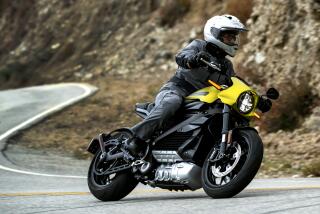GM challenges students to think green under the hood
The ground floor of the Petersen Automotive Museum’s parking garage looked like pit row at a NASCAR race. Vehicles covered in brightly colored decals were strewn about, motors revving, while folks poked about beneath hoods and discussed various aspects of speed and performance.
But instead of promoting Valvoline or Viagra, the decals sported the names of lithium-ion battery companies and state universities. The vehicles were 2005 Chevy Equinox crossovers -- not over-engined stock cars -- with power plants not found on any race track.
And instead of gasoline fumes, the odd whiff of combusting vegetable oil wafted by.
This was Challenge X, an effort by General Motors Corp., the federal government and 17 universities to develop alternatives to the gasoline-fueled internal combustion engine that powers most of the vehicles on the road in America today.
The teams at the museum Thursday have been working on their entries for three years. The challenge: to re-engineer an Equinox to increase fuel economy and reduce emissions while retaining its “consumer appeal.” GM supplied the vehicles, tech support and some funding. The Energy Department’s Argonne National Laboratory provided expertise and advice.
The competition, which ends in May, is a chance for engineering students to get experience designing and using propulsion technologies that go beyond what is available in many engineering schools: biodiesels, plug-in hybrids, hydrogen fuel cells, E85 ethanol and various combinations thereof.
“I’ve learned more on this project than I did in my entire undergraduate education,” said Frank Falcone, leader of the San Diego State University team. “It’s an incredible real-world experience.”
GM, meanwhile, gets to audition its next generation of engineering talent. The giant Detroit-based automaker has hired more than 50 student participants since Challenge X started in 2004.
“These are the ones who are going to take us into the future,” said Cindy Svetska, a GM powertrain engineering manager and a Challenge X alum. “This type of technology can’t be learned out of a book.”
The team from the University of Wisconsin-Madison was one of several that used a “through-the-road” parallel hybrid system in its Equinox. Conventional parallel hybrids such as the Honda Civic use a gasoline- or diesel-fueled engine and an electric motor in concert to drive the wheels. In a through-the-road hybrid, the engine and the electric motor operate independently, each driving one axle.
The rear axle of the UW Equinox is driven by an electric motor powered by a nickel-metal hydride battery pack. Up front is a 1.9-liter diesel engine fueled by a biodiesel blend that contain 20% soybean oil. It’s capable of running on 100% soybean oil.
“This is pretty far out there,” said Daniel Mehr, a mechanical engineering and political science major at the university.
The payoff, Mehr said, is a 95% reduction in tailpipe emissions and a big improvement in fuel economy to 36 miles per gallon city and 38 on the highway.
The team from UC Davis, led by hybrid pioneer and engineering professor Andrew A. Frank, put a Toyota Prius engine into its Equinox and turned it into a plug-in gasoline-electric hybrid with a 40-mile electric-only range.
The San Diego State squad opted for performance over fuel economy, designing a hybrid equipped with a turbocharged biodiesel-fueled engine that the team hopes will eventually produce 400 horsepower.
Spending money and brainpower to improve the mileage of a sport utility vehicle or pickup truck has drawn charges of “green-washing” from environmentalists, who would prefer to see the effort used to develop smaller vehicles capable of 100 mpg -- or that don’t use gasoline at all.
Energy Department officials, who have been sponsoring “car of the future” design competitions for almost two decades, said they tried to select vehicles that were popular with consumers -- and the crossover market was heating up when Challenge X was launched three years ago.
“These competitions are constantly evolving,” said Ed Wall of the department, who oversees the program. “We try to look at where we think things are going.”
A new competition, EcoCar: The NeXt Challenge, kicks off next fall and will have an increased focus on pollution control and fuel economy. Students will be asked to re-engineer a GM vehicle to meet California’s zero-emissions requirements.
The Challenge X winner will be announced in May after a New York-to-Washington drive by the 17 entries. In addition to medals, GM will award winners more than $50,000 in prize money.






